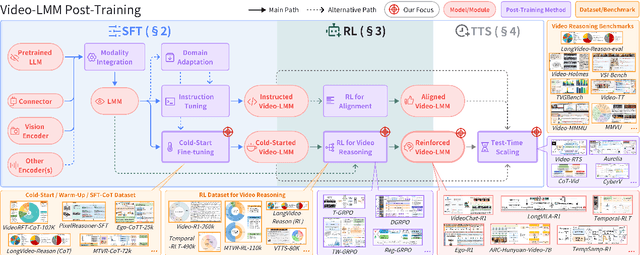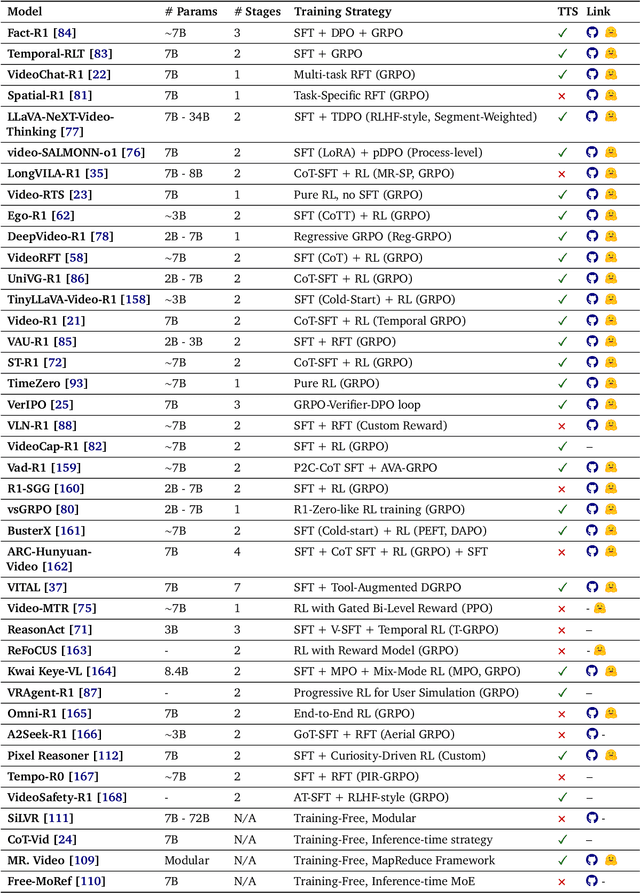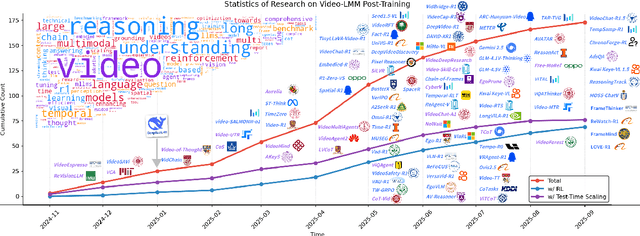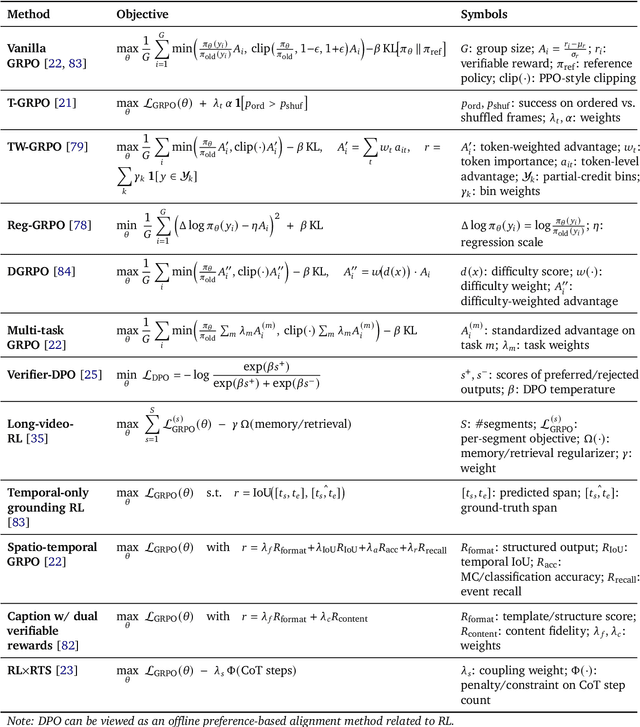Hang Hua
DAVE: A VLM Vision Encoder for Document Understanding and Web Agents
Dec 19, 2025Abstract:While Vision-language models (VLMs) have demonstrated remarkable performance across multi-modal tasks, their choice of vision encoders presents a fundamental weakness: their low-level features lack the robust structural and spatial information essential for document understanding and web agents. To bridge this gap, we introduce DAVE, a vision encoder purpose-built for VLMs and tailored for these tasks. Our training pipeline is designed to leverage abundant unlabeled data to bypass the need for costly large-scale annotations for document and web images. We begin with a self-supervised pretraining stage on unlabeled images, followed by a supervised autoregressive pretraining stage, where the model learns tasks like parsing and localization from limited, high-quality data. Within the supervised stage, we adopt two strategies to improve our encoder's alignment with both general visual knowledge and diverse document and web agentic tasks: (i) We introduce a novel model-merging scheme, combining encoders trained with different text decoders to ensure broad compatibility with different web agentic architectures. (ii) We use ensemble training to fuse features from pretrained generalist encoders (e.g., SigLIP2) with our own document and web-specific representations. Extensive experiments on classic document tasks, VQAs, web localization, and agent-based benchmarks validate the effectiveness of our approach, establishing DAVE as a strong vision encoder for document and web applications.
Video-LMM Post-Training: A Deep Dive into Video Reasoning with Large Multimodal Models
Oct 06, 2025



Abstract:Video understanding represents the most challenging frontier in computer vision, requiring models to reason about complex spatiotemporal relationships, long-term dependencies, and multimodal evidence. The recent emergence of Video-Large Multimodal Models (Video-LMMs), which integrate visual encoders with powerful decoder-based language models, has demonstrated remarkable capabilities in video understanding tasks. However, the critical phase that transforms these models from basic perception systems into sophisticated reasoning engines, post-training, remains fragmented across the literature. This survey provides the first comprehensive examination of post-training methodologies for Video-LMMs, encompassing three fundamental pillars: supervised fine-tuning (SFT) with chain-of-thought, reinforcement learning (RL) from verifiable objectives, and test-time scaling (TTS) through enhanced inference computation. We present a structured taxonomy that clarifies the roles, interconnections, and video-specific adaptations of these techniques, addressing unique challenges such as temporal localization, spatiotemporal grounding, long video efficiency, and multimodal evidence integration. Through systematic analysis of representative methods, we synthesize key design principles, insights, and evaluation protocols while identifying critical open challenges in reward design, scalability, and cost-performance optimization. We further curate essential benchmarks, datasets, and metrics to facilitate rigorous assessment of post-training effectiveness. This survey aims to provide researchers and practitioners with a unified framework for advancing Video-LMM capabilities. Additional resources and updates are maintained at: https://github.com/yunlong10/Awesome-Video-LMM-Post-Training
MMPerspective: Do MLLMs Understand Perspective? A Comprehensive Benchmark for Perspective Perception, Reasoning, and Robustness
May 26, 2025Abstract:Understanding perspective is fundamental to human visual perception, yet the extent to which multimodal large language models (MLLMs) internalize perspective geometry remains unclear. We introduce MMPerspective, the first benchmark specifically designed to systematically evaluate MLLMs' understanding of perspective through 10 carefully crafted tasks across three complementary dimensions: Perspective Perception, Reasoning, and Robustness. Our benchmark comprises 2,711 real-world and synthetic image instances with 5,083 question-answer pairs that probe key capabilities, such as vanishing point perception and counting, perspective type reasoning, line relationship understanding in 3D space, invariance to perspective-preserving transformations, etc. Through a comprehensive evaluation of 43 state-of-the-art MLLMs, we uncover significant limitations: while models demonstrate competence on surface-level perceptual tasks, they struggle with compositional reasoning and maintaining spatial consistency under perturbations. Our analysis further reveals intriguing patterns between model architecture, scale, and perspective capabilities, highlighting both robustness bottlenecks and the benefits of chain-of-thought prompting. MMPerspective establishes a valuable testbed for diagnosing and advancing spatial understanding in vision-language systems. Resources available at: https://yunlong10.github.io/MMPerspective/
MMIG-Bench: Towards Comprehensive and Explainable Evaluation of Multi-Modal Image Generation Models
May 26, 2025Abstract:Recent multimodal image generators such as GPT-4o, Gemini 2.0 Flash, and Gemini 2.5 Pro excel at following complex instructions, editing images and maintaining concept consistency. However, they are still evaluated by disjoint toolkits: text-to-image (T2I) benchmarks that lacks multi-modal conditioning, and customized image generation benchmarks that overlook compositional semantics and common knowledge. We propose MMIG-Bench, a comprehensive Multi-Modal Image Generation Benchmark that unifies these tasks by pairing 4,850 richly annotated text prompts with 1,750 multi-view reference images across 380 subjects, spanning humans, animals, objects, and artistic styles. MMIG-Bench is equipped with a three-level evaluation framework: (1) low-level metrics for visual artifacts and identity preservation of objects; (2) novel Aspect Matching Score (AMS): a VQA-based mid-level metric that delivers fine-grained prompt-image alignment and shows strong correlation with human judgments; and (3) high-level metrics for aesthetics and human preference. Using MMIG-Bench, we benchmark 17 state-of-the-art models, including Gemini 2.5 Pro, FLUX, DreamBooth, and IP-Adapter, and validate our metrics with 32k human ratings, yielding in-depth insights into architecture and data design. We will release the dataset and evaluation code to foster rigorous, unified evaluation and accelerate future innovations in multi-modal image generation.
The Tenth NTIRE 2025 Efficient Super-Resolution Challenge Report
Apr 14, 2025Abstract:This paper presents a comprehensive review of the NTIRE 2025 Challenge on Single-Image Efficient Super-Resolution (ESR). The challenge aimed to advance the development of deep models that optimize key computational metrics, i.e., runtime, parameters, and FLOPs, while achieving a PSNR of at least 26.90 dB on the $\operatorname{DIV2K\_LSDIR\_valid}$ dataset and 26.99 dB on the $\operatorname{DIV2K\_LSDIR\_test}$ dataset. A robust participation saw \textbf{244} registered entrants, with \textbf{43} teams submitting valid entries. This report meticulously analyzes these methods and results, emphasizing groundbreaking advancements in state-of-the-art single-image ESR techniques. The analysis highlights innovative approaches and establishes benchmarks for future research in the field.
Caption Anything in Video: Fine-grained Object-centric Captioning via Spatiotemporal Multimodal Prompting
Apr 09, 2025Abstract:We present CAT-V (Caption AnyThing in Video), a training-free framework for fine-grained object-centric video captioning that enables detailed descriptions of user-selected objects through time. CAT-V integrates three key components: a Segmenter based on SAMURAI for precise object segmentation across frames, a Temporal Analyzer powered by TRACE-Uni for accurate event boundary detection and temporal analysis, and a Captioner using InternVL-2.5 for generating detailed object-centric descriptions. Through spatiotemporal visual prompts and chain-of-thought reasoning, our framework generates detailed, temporally-aware descriptions of objects' attributes, actions, statuses, interactions, and environmental contexts without requiring additional training data. CAT-V supports flexible user interactions through various visual prompts (points, bounding boxes, and irregular regions) and maintains temporal sensitivity by tracking object states and interactions across different time segments. Our approach addresses limitations of existing video captioning methods, which either produce overly abstract descriptions or lack object-level precision, enabling fine-grained, object-specific descriptions while maintaining temporal coherence and spatial accuracy. The GitHub repository for this project is available at https://github.com/yunlong10/CAT-V
Generative AI for Cel-Animation: A Survey
Jan 08, 2025



Abstract:Traditional Celluloid (Cel) Animation production pipeline encompasses multiple essential steps, including storyboarding, layout design, keyframe animation, inbetweening, and colorization, which demand substantial manual effort, technical expertise, and significant time investment. These challenges have historically impeded the efficiency and scalability of Cel-Animation production. The rise of generative artificial intelligence (GenAI), encompassing large language models, multimodal models, and diffusion models, offers innovative solutions by automating tasks such as inbetween frame generation, colorization, and storyboard creation. This survey explores how GenAI integration is revolutionizing traditional animation workflows by lowering technical barriers, broadening accessibility for a wider range of creators through tools like AniDoc, ToonCrafter, and AniSora, and enabling artists to focus more on creative expression and artistic innovation. Despite its potential, issues such as maintaining visual consistency, ensuring stylistic coherence, and addressing ethical considerations continue to pose challenges. Furthermore, this paper discusses future directions and explores potential advancements in AI-assisted animation. For further exploration and resources, please visit our GitHub repository: https://github.com/yunlong10/Awesome-AI4Animation
FINECAPTION: Compositional Image Captioning Focusing on Wherever You Want at Any Granularity
Nov 23, 2024



Abstract:The advent of large Vision-Language Models (VLMs) has significantly advanced multimodal tasks, enabling more sophisticated and accurate reasoning across various applications, including image and video captioning, visual question answering, and cross-modal retrieval. Despite their superior capabilities, VLMs struggle with fine-grained image regional composition information perception. Specifically, they have difficulty accurately aligning the segmentation masks with the corresponding semantics and precisely describing the compositional aspects of the referred regions. However, compositionality - the ability to understand and generate novel combinations of known visual and textual components - is critical for facilitating coherent reasoning and understanding across modalities by VLMs. To address this issue, we propose FINECAPTION, a novel VLM that can recognize arbitrary masks as referential inputs and process high-resolution images for compositional image captioning at different granularity levels. To support this endeavor, we introduce COMPOSITIONCAP, a new dataset for multi-grained region compositional image captioning, which introduces the task of compositional attribute-aware regional image captioning. Empirical results demonstrate the effectiveness of our proposed model compared to other state-of-the-art VLMs. Additionally, we analyze the capabilities of current VLMs in recognizing various visual prompts for compositional region image captioning, highlighting areas for improvement in VLM design and training.
VidComposition: Can MLLMs Analyze Compositions in Compiled Videos?
Nov 19, 2024



Abstract:The advancement of Multimodal Large Language Models (MLLMs) has enabled significant progress in multimodal understanding, expanding their capacity to analyze video content. However, existing evaluation benchmarks for MLLMs primarily focus on abstract video comprehension, lacking a detailed assessment of their ability to understand video compositions, the nuanced interpretation of how visual elements combine and interact within highly compiled video contexts. We introduce VidComposition, a new benchmark specifically designed to evaluate the video composition understanding capabilities of MLLMs using carefully curated compiled videos and cinematic-level annotations. VidComposition includes 982 videos with 1706 multiple-choice questions, covering various compositional aspects such as camera movement, angle, shot size, narrative structure, character actions and emotions, etc. Our comprehensive evaluation of 33 open-source and proprietary MLLMs reveals a significant performance gap between human and model capabilities. This highlights the limitations of current MLLMs in understanding complex, compiled video compositions and offers insights into areas for further improvement. The leaderboard and evaluation code are available at https://yunlong10.github.io/VidComposition/.
MMCOMPOSITION: Revisiting the Compositionality of Pre-trained Vision-Language Models
Oct 13, 2024



Abstract:The advent of large Vision-Language Models (VLMs) has significantly advanced multimodal understanding, enabling more sophisticated and accurate integration of visual and textual information across various tasks, including image and video captioning, visual question answering, and cross-modal retrieval. Despite VLMs' superior capabilities, researchers lack a comprehensive understanding of their compositionality -- the ability to understand and produce novel combinations of known visual and textual components. Prior benchmarks provide only a relatively rough compositionality evaluation from the perspectives of objects, relations, and attributes while neglecting deeper reasoning about object interactions, counting, and complex compositions. However, compositionality is a critical ability that facilitates coherent reasoning and understanding across modalities for VLMs. To address this limitation, we propose MMCOMPOSITION, a novel human-annotated benchmark for comprehensively and accurately evaluating VLMs' compositionality. Our proposed benchmark serves as a complement to these earlier works. With MMCOMPOSITION, we can quantify and explore the compositionality of the mainstream VLMs. Surprisingly, we find GPT-4o's compositionality inferior to the best open-source model, and we analyze the underlying reasons. Our experimental analysis reveals the limitations of VLMs in fine-grained compositional perception and reasoning, and points to areas for improvement in VLM design and training. Resources available at: https://hanghuacs.github.io/MMComposition/
 Add to Chrome
Add to Chrome Add to Firefox
Add to Firefox Add to Edge
Add to Edge